Last Update: June 2003.
In this webpage is presented the concept of economic quality of a reserve, including an application of this concept for mutually exclusive project selection under uncertainty, and some FAQs. The topics are presented below:
![]() Introduction
to Economic Quality of a Reserve
Introduction
to Economic Quality of a Reserve
![]() Application:
Selection of Mutually Exclusive Alternatives under Uncertainty
Application:
Selection of Mutually Exclusive Alternatives under Uncertainty
![]() Some
FAQs on the Economic Quality of a Developed Reserve
Some
FAQs on the Economic Quality of a Developed Reserve
This concept was presented at the Real Options Workshop, in May 1998, Stavanger, Norway. I take some slides from the my workshop presentation, but with some intermediates comments.
The undeveloped reserve value (F) is the real option value to develop the reserve. A developed reserve is a producing (or ready to produce) asset with value V. We can think V in unitary value ($/bbl, where bbl = barrel) or as the value of the whole developed reserve (in million $).
The economic quality of V depends of the nature (rock/fluids properties), but also depends of the location (if onshore or offshore; shallow or deepwaters; fiscal/tax regime of the host-country; etc.) and of the development project (depending of the capital intensity alternative, petroleum can be extracted faster or slower; with high or low operational costs; etc.).
The concept of economic quality of reserves catches these features. It can be estimated using the traditional discounted cash flow or more sophisticated approaches (e.g., including abandonment option).

In the proportional model (reserve value proportional to oil prices) also named The Business Model, is easy to work with both charts for the option value, F x V and F x P (if you have one chart, is easy to get the other one). However, the concept of economic quality of a reserve works with the F x P chart, because it is the payoff line inclination.
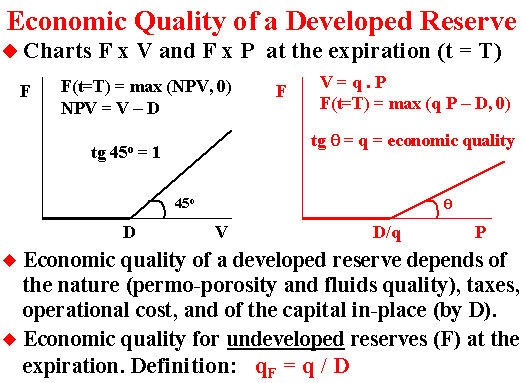
An alternative definition for qF, the economic quality of the undeveloped reserve, could be:
If t = T, qF = Max[NPV, 0]/P; and
If t < T, qF = F/P
With this alternative qF definition, by multiplying qF times P, we get the value of one barrel of undeveloped reserve (F).
This is similar with the case of q itself: q times P gives V, the value of the developed reserve.
![]()
The choice of the better alternative of development is one important
step that is performed through technical-economic feasibility studies,
where several alternatives that imply in several different economic
quality for the resulting developed reserve.
The concept of economic quality permits an easy comparison of alternatives
with different investments, operational costs and revenues, considering
the timing to develop and the uncertainty on oil prices.
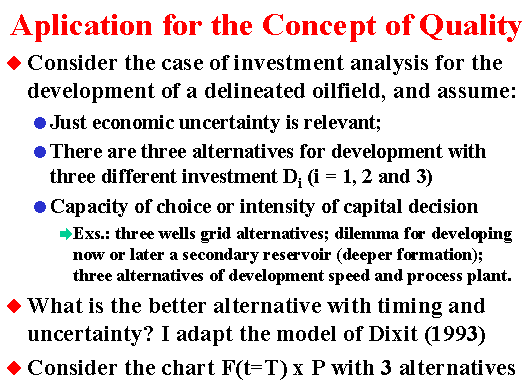
The alternatives have different investment costs. Higher investment
alternatives have benefit of faster production (more wells and/or higher
processing facilities capacity) and/or lower operational costs.
What is the optimal capital intensity under uncertainty?
This model is adapted from: Dixit, A.K. (1993): "Choosing Among
Alternative Discrete Investment Projects Under Uncertainty". Economic
Letters, vol.41, 1993, pp.265-288. However, I consider finite-lived
real options, whereas Prof. Dixit considered perpetual options.
Recently, Décamps & Mariotti & Villeneuve (2003): "Irreversible
Investment in Alternative Projects", Working Paper from Université
de Toulouse and London School of Economics and Political Science, give
important and rigorous additional contributions to this model, which will
be pointed out soon in this page.
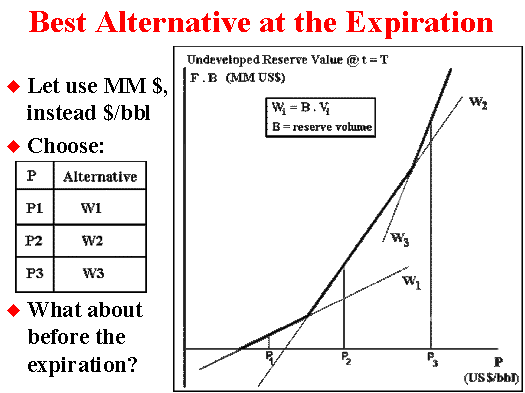
The higher inclination (or higher quality q) alternative 3 has the higher investment. Of course alternatives with higher investment but with lower quality (inclination) is dominated by higher quality alternatives and can be eliminated.
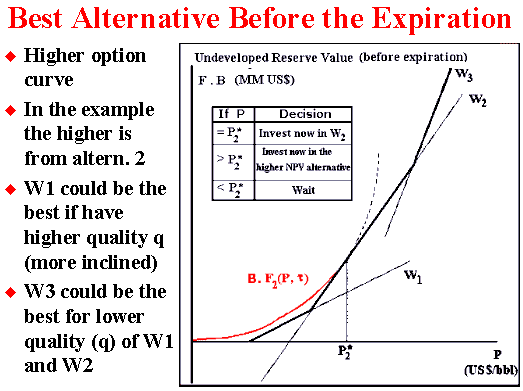
It is easy to get the curves for the option alternatives with
spreadsheets like Timing. To compare, superpose the option curves
and look for the higher one. With this practical approach we can see some
special cases not addressed before by Dixit (1993). Even being an
approximation (see below why), the numerical error on the value of the
option is very small so that it possible to see that in most cases there
is an intermediate waiting region between the exercise of alternatives 2
and 3. So that for P > P*2, we can see a region that the
option value of waiting (F3) is higher than both NPV2
and NPV3.
Motived with this somelike surprising experimental early result, in 2000
were started two projects between PUC and Petrobras - from the Pravap-14
research projects portfolio, which confirmed this hypothesis. One
Pravap-14 project was a more flexible and general determination of the
optimal rules regions by using genetic algorithms (developed with
Electrical Engineering Department). The other Pravap-14 project was more
rigorous (but specific for simpler cases) using the traditional differential
equation approach (developed with Industrial Engineering Department).
Both used finite-lived options. In year 2002 we started the second phase
of both projects, adding other realistic details with more complex issues.
By using a C++ PRAVAP-14 software developed at Industrial Engineering
Department (PUC-Rio), it is possible to get the following thresholds chart
showed below (and presented at MIT Seminar on Real Options, May 2002).
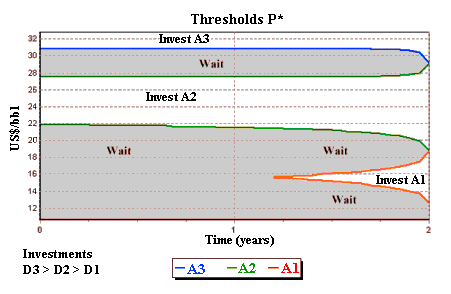
Working independently and with perpetual options, Décamps & Mariotti & Villeneuve (2003) proved mathematically that the waiting region around the point of indifference between NPV2 and NPV3 always occurs (non-empty region) if sometimes is optimal to invest in alternative 2. They showed that if "investment in the smaller scale project is sometimes optimal, ... the optimal investment region is dichotomous.". In their proposition 3.2, they show that the indifference point where NPV2 = NPV3 does not belong to the exercise region. They proved with help of the sophisticated concept of local time for the continuous semimartingale P applied at this indifference point. Before this paper, I was thinking that the Dixit's (1993) claim even not being typical could be possible. But they proved that it cannot be possible.
Probably the conclusion from Décamps & Mariotti &
Villeneuve (2003) is even more general, being also true for finite-lived
options except at the expiration.
I thank to Professor Thomas Mariotti for letting me know about this paper
and for the nice discussion.
With this new insight in mind, we can correct the Dixit's option
value chart by setting a case that always occurs in the figure below
(analogous to Figure 1 from Décamps & Mariotti &
Villeneuve, 2003):
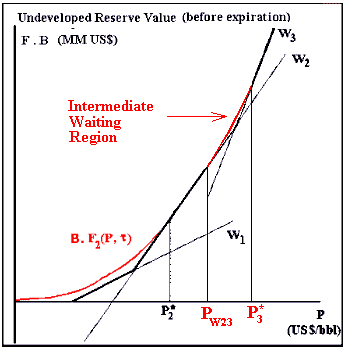
In the above figure, the option curve (red line) in the superior part of
this figure (between PW23 and P*3) is the
intermediate waiting region. Décamps & Mariotti &
Villeneuve (2003) showed that this region always exists (if sometimes is
optimal exercise alternative 2, as occurs in the figure).
Numerically the error can be small if exercising the option (higher NPV as
suggested by Dixit in 1993) rather than waiting in this intermediate
optimal waiting region. So, even not being correct, the error using the
Dixit's insight can be small in practice. However, the size of the waiting
interval (between PW23 and P*3) can be a large
range.
But in addition to be optimal the "waiting and see" policy at this region, the option curve value (let us call B . F3) can also indicate something about an optimal project scale. If P belongs to this intermediate waiting region, the optimal scale project for an immediate investment exercise must have a quality q* equal to the derivative of this option value, that is, q*(P) is equal to derivative of B . F3 in relation to P. This conclusion is derived from the smooth-pasting property at the optimal option exercise. This project does not exist in the figure above, but the optimal scale in this case is an intermediate scale between the alternatives 2 and 3. So, there is an interesting practical link between the concept of quality q and the smooth-pasting property for the optimal scale.
The approach using the concept of economic quality of a reserve can be extended to more complex situations. See the slide below.
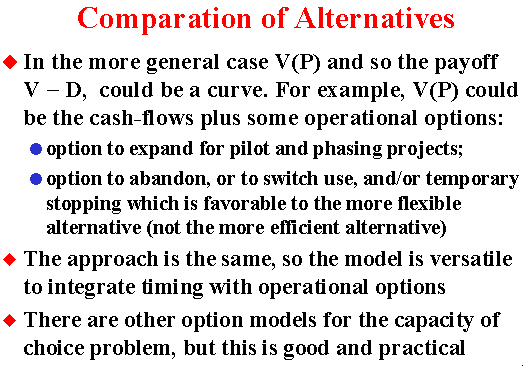
For the fiscal regime of concessions (USA, UK, Brazil, and others), the linear equation for the NPV with the oil prices is at least a very good approximation. For the fiscal regime of production sharing (used for example in Africa), the same is not true (for the production sharing case including the NPV x P chart, click here).
If the underlying asset V is a linear function of P, that is, V = a P + b, and if the constant a > 0, we can say that V and P are perfectly positively correlated (coefficient of correlation between V and P is equal + 1). See the proof for example in the DeGroot & Schervish's text, p.218 (Probability and Statistics, Addison-Wesley, 3rd Edition, 2002).
The figure below presents two different linear equations for the NPV equation (NPV = V - D), using different definitions for the value of the underlying asset (the reserve value V). One is named "Business Model" and the other one is named "Rigid Cash Flow Model".

In order to understand the "Business Model", think about the
market value of one barrel of reserve v (that is, v is the price of the
barrel of reserve). If this reserve price v is directly related with the
long-run oil prices, let be q the factor of proportionality so that v
= q P. For developed reserve transactions, as higher is the price per
barrel of a specific reserve, as higher is the economic quality for that
reserve. For a fixed reserve volume and fixed oil price, as higher is the
factor q as higher is the value of this reserve.
By using this insight, the value of a reserve V is the price of the barrel
of reserve v times the size of this reserve B, that is, V = v B.
The equation for the developed reserve value V is:
V = q B P.
This is the easiest way to work with the three most
relevant variables to access the value of a developed reserve, using
business thinking, which is very adequate for market valuation. The value
q can be assessed either by market transactions in markets like USA (see
Adelman & Koehn & Silva, 1989; and Adelman & Watkins, 1996) or
by using the discounted cash flow approach.
In the first case, is necessary to consider the appropriate discounting
effect on q in order to put in present value the reserve value V (see also
the FAQ 3 below in this page). Note that q is the only parameter to
consider the discounting effect in the equation of V.
In the second case, consider the spreadsheet NPV estimate for a certain
(average) oil price. In a chart NPV x P this base-case NPV estimative, is
one point of our straight line, the other one is defined by NPV(P=0) =
- D. The figure above presents the link
between this chart and the equation for the "Business Model".
The Rigid Cash Flow Model is given by the equation:
V = q' B P - C.
Where C is a kind of fixed operational cost in present value. In the Rigid Cash Flow Model the quality of reserve is given by q' and is higher when compared with the quality from the business model.
In comparison with the "Business Model", the model named "Rigid Cash Flow" is more sensible to the oil prices. In general this means higher real options value F(P) for the "Rigid Cash Flow Model". In this aspect the "Business Model" is more conservative.
The "Rigid Cash Flow Model" assumes no correlation between the
operational cost (C) and the oil price (P). In reality, microeconomic
logic points that a positive correlation is expected to occur between C
and P because the main costs are industry-specific. For example, wells
maintenance are done by specific rigs, oil transport demands tankers, many
specific petroleum services, etc. The microeconomic logic of correlation
means that higher oil prices tends to increase the demand for specific
petroleum services, increasing the operational cost C, and vice versa.
The truth on the correlation lies between the "Business Model"
(perfect positive correlation) and the "Rigid Cash Flow Model"
(zero correlation). However, an intermediate model means to assume the
operational cost C as stochastic, introducing some additional complexity
to the model.
More about these payoff models, the specific spreadsheets Timing Version Business Model and Timing Version Rigid Cash Flow Model, non-linear models, proofs, etc., see the webpage Linear and Nonlinear Models for the Underlying Asset V(P) and the NPV Equation.
I list here some FAQs (frequently asked questions) and practical issues. Let us go to the first question:
1) Is this linear model (V linear in P) reasonable?
The easiest way to apply the concept of economic quality of a reserve is
by using the linear model because the quality q is constant.
However, the quality concept doesn't depend on the linear model.
If V is a non-linear function of P, the quality q is a function of P equal
the derivative of V(P), that is, q(P) = ![]() V/
V/
![]() P.
P.
The assumption of linearity has been considered reasonable in the real options literature, see for example Dixit & Pindyck (1994, chapter 12, section 1) and Paddock, Siegel & Smith (1988).
Schwartz ("The Stochastic Behavior of Commodity Prices:
Implications for Valuation and Hedging", Journal of Finance,
vol.52, number 3, July 1997, see p.971) results give us another important
argument, using very different stochastic models that driven heavily on
futures markets insights (the two and three-factor models).
These models imply an underlying project value that is linear with the
spot price (Schwartz, 1997, Fig.13), the inclination of his two or three
factor NPV is exactly our economic quality q.
Schwartz (1997) two factors model presents the following equation for the forward (or futures, the interest rate is non-stochastic here) prices F:
F(P, d, t) = S exp{- d [(1 - e- h t )/ h] + A(t) }
Where A(t) depends of the time and the parameters process, but not
depend neither on the spot price S nor on the convenience yield
d.
h is the reversion speed of the stochastic
convenience yield.
Note that forward (futures) prices F is a linear function of the spot
price S.
Now Schwartz calculates the NPV per unit of product (his equation 49) as
a function of the present value of the commodity produced at the instant
t, which is the discounted value from the forward prices, less the present
value of the operation costs (he assumes known and not a function of S)
less the unitary investment cost (which is not a function of S).
Using futures equation for commodities prices like the presented above,
Schwartz present the NPV equation for a project, which implies in the linear
relation NPV with spot prices for two factors model, as well as
for three factors models and for geometric Brownian motion (his Fig.13).
For his two factors model, but for time varying production Q(t), following a typical decline in petroleum case, the economic quality of a developed reserve is:
q = ![]() Q(t) exp{- d [(1 -
e- h t )/ h]
- r t + A(t) }
Q(t) exp{- d [(1 -
e- h t )/ h]
- r t + A(t) }
In his example the production last for ten years, using annual discretization for NPV calculus. A(t) is as before.
As pointed out by Schwartz (1997, Fig.13), for pure mean-reversion
models the NPV is not a linear function (even being a good approximation
in many cases).
2) A practical issue: How to calculate the economic quality of a developed reserve if I have the spreadsheet with the traditional discounted cash flow?
Everybody has this kind of spreadsheet, so you get the NPV (net present
value), the break-even price (unitary cost of production, UCP, the price
which the NPV is zero), and the after-tax investment (present value) D.
Lets work with unitary value (per barrels of oil equivalent, BOE). So,
think unitary (per BOE) values for NPV and D.
The most common practical problem is related the consequences of
non-linearity of the function V(P) for most spreadsheets results, even
when linearity is a very good approximation.
The figure below shows, for a non-linear V(P), two points (A and B) which
has two differents economic qualities. One point (B) is the current
valuation (with current petroleum prices) resulting in the NPV displayed.
The other point (A) is the point which NPV is zero. This is the break-even
or unitary production cost (UPC).
The inclination q is different depending what point is choosen for
evaluate q.
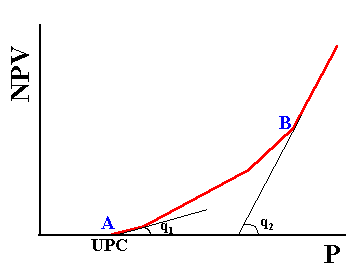
So, to be consistent with the spreadsheet discount cash flow analysis
for the current price and the associated NPV, this means you get another
UPC (different of the spreadsheet). If you is consistent with UCP, this
means that the NPV for the same price level will be different of the DCF
spreadsheet. What the better point to estimate q?
I prefer to evaluate q in the current situation (instead in the UPC
point), because the estimative of cash flows generally are more reliable
for the base-case.
The method relying on the actual NPV and associated current price level,
that is, relying on the relation q = V/P(t=0) is presented below. The
steps to calculate q and V are:
1) Calculate D, the unitary (per BOE) present value of investment cash
flow, net of fiscal benefit (after-tax);
2) Calculate V = NPV + D, where NPV is the net present value per
BOE; and
3) Calculate q = V/P(t=0); where P(t=0) is the current petroleum price
used (or an equivalent price for a mix of products like gas + oil).
The method relying on the break-even value (UPC), that is, relying on
the relation q = D/UPC, is presented below. The steps to calculate q and V
are:
1) Calculate D, the unitary (per BOE) present value of investment cash
flow, net of fiscal benefit (after-tax);
2) Calculate q = D/UPC, where UPC = unitary production cost or break-even
cost; and
3) Calculate V = NPV + D
3) Is there some effect of discount rate on the value of the economic quality of developed reserve?
Yes. The discount rate (r) affect the
economic quality of the reserve (q).
The two main discount rate effects on q are:
In the last case, when analysing exploratory prospects (drill or not the
wildcat), the discount factor effect makes the value of q even lower than
the one used in development applications.
In short, is not possible to compare directly the 1/3 rule (average q =
33.3% for USA developed reserves) with the values used in both
applications, development investment and exploratory investment, due the
discount rate effect.
For example: For a discount rate of 10% p.a., an offshore reserve if is
producing has a q = 33.3%; but if it is an economic study of development
investment that takes time to build of three years, for the same reserve q
= 24.7%; and if it is an exploratory investment study so that the
first-oil will come in 5 years, value of the q drops to 20.2%.